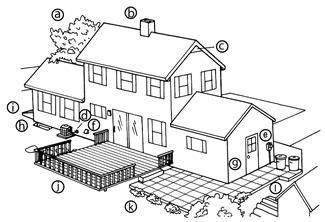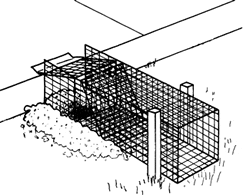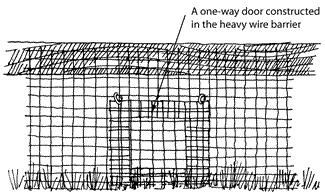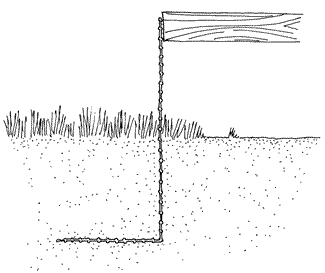What Type Of Wild Animal Will Get Under Your House And Destroy Duct Work
Evicting Animals From Buildings
On this folio:
- A 7 Step Do-It-Yourself Strategy
- One-Way Doors
- Boosted Information
Overview
Occasionally a raccoon, skunk, squirrel, or other animal will find shelter in or under a house, shed or other structure. These animals may occupy an area sporadically, using the site only ii or three consecutive days or nights until available food sources are exhausted. Or, they may cull to overwinter there if the weather condition are favorable. During the convenance flavour, females attracted to warm, dry, hands dedicated areas may try to give nativity to their immature in these settings.
You may choose to let the brute utilise the area if it doesn't pose a problem to you, your family unit, your pets or other animals. However, uneaten prey, urine, or carrion may create odors and become a health chance. Animals may also make considerable noise, chew on building parts, or destroy insulation during the nest-building process.
Should you choose to remove the fauna, you tin practice it yourself or rent an animal damage command amanuensis (Contact your local Regional Wildlife Office for animal damage control agents in your area.) An animate being harm command agent is recommended for work that poses health or safety hazards. Examples include removing a large accumulation of droppings, removing a mother beast and her immature, or working in a precarious location.
Annotation: State wild animals offices do not provide brute removal services, simply they can provide the names of individuals and companies that do. To encourage an animal to move on its own or to evict it from a place where information technology is undesired, follow the steps below. (For information nigh evicting bats, too see Bats.)
A 7 Footstep Exercise-It-Yourself Strategy
Before taking whatever steps to resolve a wildlife/human conflict in or around a structure, y'all must be sure of three things:
- What species is involved;
- Where the animal(due south) are entering;
- Whether or not young animals are present.
Then, information technology is of import to continue in a humane mode that also prevents the problem from reoccurring.
-
Identify the Suspect
You need to place the problem species before you can resolve the problem. Note the time and location of calls, cries, or scampering noises and look exterior for the animals themselves. You tin ofttimes hearSquirrels (except flying squirrels) tend to go out effectually sunrise and return betwixt late afternoon and dark, so you can identify them during daylight hours. Flying squirrels, raccoons, skunks, and opossums often brand noise from night until just earlier dawn; you can sometimes see well plenty to identify them exterior at night.
If you can't see the animal, try to place it from its method of entry, odor (skunk), tracks, droppings, or whatsoever harm it is causing. (Read the advisable description in this series for specifics on any suspects.) Raccoons often go out scratches, tracks, and body oil stains where they climb upwardly downspouts, trees, or the corners of buildings to gain admission to roofs. Rats and skunks frequently dig nether foundations or physical slabs.
Use a bright flashlight to locate holes in shadowy areas, and a ladder to search for holes high on a construction.
Always be cautious around creature debris, some of which tin be harmful to people.
-
Locate All Possible Entrances
Audit the outside of the structure for obvious entrances. The fauna may be using more than than one entry, and entry holes are often smaller than you might expect. For case, petty brown bats tin enter a business firm through an opening smaller than i square inch, while grey squirrels chew open baseball game-size entries.The opening where utility cables and pipes enter a structure, cranium louvers, roof vents, and holes in roofs, siding, soffits, and foundations (Fig. 1) are all common points of entry.

Figure i: Cartoon Credit - Wild Neighbors
Utilize a brilliant flashlight to locate holes in shadowy areas, and a ladder to search for holes high on a structure.
The house and yard offer many possibilities for shelter and cover. An overhanging branch (a) tin provide access to a roof. An uncapped chimney (b) or broken vent (c) tin can provide admission to warm, dry living quarters. Small mammals tin can enter where wiring or pipes enter the house (d) and (due east), vents are left uncapped (f), doors are improperly fitted (k), ground-level window sills and foundations accept gaps (h), and bulkhead doors (i) are not tight. Animals can as well discover shelter nether decks (j). Burrowing animals may tunnel beneath patios (k) or wood piles (l). (Fig. 1)
-
Locate the Animal's Main Signal of Entry
Await for a freshly dug pigsty, fresh animate being tracks, dirt piles, nest materials, and/or hairs stuck effectually a narrow pigsty in the roof, siding, or foundation. To verify that an entry is being used, lightly stuff wadded-up newspaper, burlap, or dirt in the entry and watch daily to see if the material has been moved. Do not use this technique if you think bats or birds are entering the area considering they are not capable of pushing aside the newspaper and volition be trapped inside.Equally an alternative, if yous suspect an opening at ground level, smooth dirt or sprinkle talcum powder outside the entry, covering an area large enough to record footprints every bit the animal enters or exits. Do non use flour, which may attract a hungry animal.
If you lot can't observe the entry, very advisedly enter the cranium, crawlspace, or other surface area during daylight hours with a strong flashlight or headlamp. Article of clothing gloves and a dust mask and exist alert for animals, their debris, or indications of chewing. From inside, you can better inspect the screening on the vents for signs of entry. Plow off your low-cal to reveal daylight coming through whatever holes in the roof or walls. Identify markers in these holes so yous can easily locate them from the exterior when it comes fourth dimension for repair.
-
Determine Whether Young Animals Are Involved
Continue with the eviction process merely after verifying that no young animals are present. Because each situation and each animal is different, bank check for young even if it seems too early or too belatedly in the year for them to be present. Failing to practise so can lead to major problems with an unhappy female person that has been separated from her young.When you enter the attic, clamber space, or other enclosure, search for a nest or immature. Focus on the area near the active entry or where you have been hearing noises. Squirrels often utilise insulation and other torn-upwards material to make nests, and site them along the outer edges of an attic. Raccoons and skunks do not make an obvious nest.
Loudly pound on a flooring joist, ceiling joist, or wall to become the young to motion or make a noise that would alert yous to their presence. Use a stick to search for baby animals in hard-to-reach places, such as in a wall between studs.
Annotation: Apply care and then that yous do non injure the animals. Never arroyo a female parent with her young, equally her protective instincts can make her unsafe.
-
Adios The Family unit Only If It Is Necessary
If it is necessary, attempt to get the mother to move the youngIf young are present, the nigh humane thing to do is to go out the family alone until information technology moves on its own. Squirrels, rodents and raccoons, however, often cause harm in attics or betwixt walls, and it may exist necessary to evict the entire family to prevent further damage to the building.
If the young need to exist moved, use i of the harassment techniques described in Pace 6 to try to become the mother to motion them herself. Even in an emergency, females can ofttimes be persuaded to move their immature, thus avoiding the need to trap or euthanize families.
If yous are fortunate, the mother may move her young, even newborns, to an alternate den within an hr or so after they accept been disturbed. If the weather is not favorable, or she has to find a new den or build a new nest, it may take a few days. Each animal is different. Some may be quite stubborn. To help the eviction process go smoothly, go on children and pets abroad from the animal's entry.
Note: Whenever you try to evict a mother animal and her immature, there is a risk that she may get out some or all of her young behind. If the immature end upwards as orphans they volition not survive. In this case, take the orphan(s) to a local wildlife rehabilitator or euthanize it. Do not attempt to care for the animal yourself because without the proper skills, you could farther damage it. Also, it is illegal to continue wild fauna without a permit. (See: Wildlife Rehabilitators.)
If you are non successful in evicting the family unit and the young must be moved immediately, the female person can exist live-trapped and the dependent immature placed in a conditions-protected releasing box. Identify the box exterior and adjacent to the point of entry after the entry has been sealed to prevent reentry. At this point, the mother tin can relocate her young at her ain pace. It is recommended that an Animal Impairment Control agent who has experience alive trapping exercise this work.
-
Seal Off the Surface area in Stages
The preferred pick is to encourage the animal to leave and then to make sure it does not return or that a dissimilar animal does not take its place.- Seal off all entries except the active ane.
Because the brute will seek other ways to become dorsum inside, you must seal off any potential entries. Employ forest, quarter-inch mesh galvanized hardware cloth, sail metal, aluminum flashing, or another sturdy fabric. Plug small holes in hard-to-attain locations with wadded upwards wire, copper Stuf-fit, or copper or stainless steel mesh scouring pads (steel wool apace corrodes after becoming wet). If necessary, caulk the openings to seal them; paint will help hide the repair job. With merely the animal's regular archway remaining, and during a period of fair weather, encourage the animate being to leave using one or more than of the following harassment methods. (Occasionally when squirrels, raccoons, opossums and other young animals leave their nest eight to 10 weeks afterward birth, ane of the young stays behind; once more, use the eviction methods described beneath.)
- Harass the fauna.
Only rarely will banging on the ceiling, wall or floor in the vicinity of the fauna cause it to vacate.
If mobile young are present, lightly pack the active entry hole with wadded-upward newspaper, burlap, or dirt, and repack information technology whenever you see information technology open. Cake the hole plenty then the animal must expend energy to reopen it, but will not be trapped inside. When the barrier has not been removed for three days during fair weather condition, the beast has gone and yous tin can make repairs to prevent reentry.
It may exist necessary to enter the area where you think the brute and/or its young may exist sleeping. Exist certain to wear gloves and a dust mask or respirator, and use a powerful flashlight.
Shine the light on the adult brute, bang on a rafter, clap your easily and tell the animal to get out, or exercise anything that does non put yous or the animals in danger. If the adult is outside, tamper with the nest by pulling off the top and/or sliding it over a pes or so.
In addition, roll rags into tight assurance secure them with twine or record; sprinkle them with predator urine available from farm supply centers, hunting shops, or over the Net; and throw or place them near the nest. Or, sprinkle stinky kitty litter around the nest to create an unpleasant atmosphere. Raccoon Eviction Fluid, works well with that species.
The creature(s) may leave inside the hour or it may take a couple of days. Revisit the area to see if the immature are gone, and to make certain the adult did not simply move them elsewhere inside the structure.
Use wadded-up newspaper as described to a higher place to verify that the animate being is gone and make the necessary repairs to preclude reentry.
- Intensely harass the animal.
If the previous methods do non work, try these:
Use a mechanic's vivid drop light (a grid-enclosed bulb) or other portable lite. Hang information technology upward then it is non near burnable objects and light up the animal's sleeping area. A fluorescent light volition conserve electricity and keep the heat level down. In improver, you tin can put a radio in the expanse and play a talk station equally loud as you lot can tolerate. If the animate being moves to an unlit area, transfer the light and radio or install an boosted light and radio. Leave the lights and radio on continuously, mean solar day and nighttime, to interrupt the animal'southward sleep.
(There is no scientific evidence that commercially available ultrasonic devices will drive animals from buildings. Animals chop-chop get accustomed to the noise or move to a noise-free area; the ultrasound does not become through objects so they quickly lose their intensity with distance.)
Use a visual verification, a one-way door (see "One-Way Doors"), or the wadded-up newspaper or talcum-powder approach to verify that the animal has gone. Be patient, every bit it may accept several days for the animal to move, peculiarly in urban areas where animals are used to lights and noises.
If these methods are unsuccessful, please reach out to your Regional Wildlife Office, District Game Warden, or Certified Fauna Damage Command Amanuensis.
- Seal the remaining entry hole while the brute is outside feeding.
Annotation: Do not do this if young are present; they will be separated from their mother, which will quickly create other problems.
- First, assemble all of the materials that you will need to seal the entry. Adjacent, place wadded-upward newspaper in the entry or use talcum powder as described in Footstep 3 to determine that the animal has gone exterior. For squirrels and other species that are active during the mean solar day, expect for the signs that they have exited early in the morn. For raccoons and other nocturnal species, begin the surveillance an hr subsequently dark. Survey the entry frequently, equally animals will return to rest or escape bad weather condition. When y'all are certain the animal is outside, seal the entry.
- Seal off all entries except the active ane.
-
Follow Up
If you hear dissonance coming from inside the enclosure after sealing the entry, it is probable that there is still an fauna inside. Reopen the area and repeat Step vi until all the animals accept departed, then reseal the entry. If the animal volition not leave the area, you can live-trap it.Make frequent inspections for two weeks to make sure an creature has not tried to reenter using the original opening or a new entry. Considering an beast leaves a scent trail that other animals may find and follow, and this smell lasts for several months or fifty-fifty longer -- yous may want to obliterate the scent with pepper spray or a commercial gustation repellent such every bit Ropell. Repeat the application if the area is exposed to pelting.
Inspect for piles of droppings or other sign of activity.
If an animal has spent a lot of time in an area with exposed wiring, inspect the area for wire damage or have an electrician audit information technology. Too audit for damage to insulation and heating ducts.
Dorsum to top
One-Style Doors
An active entry tin be fitted with a one-way door so an animal can get out but non reenter. A i-way door takes time and endeavor to install correctly, but is effective when yous want to adios squirrels, raccoons and other above-ground animals from buildings. Commercial one-way doors that trap burrowing animals (Fig. two) are available from companies advertising on the Internet (search for "Animal Control" or "Animal Traps").

Figure 2: Artist Credit - Wild Neighbors
A commercial one-way door will deter animals from burrows under houses and concrete slabs. (Fig. 2)
Use a one-fashion door only when you lot are sure that no young will exist trapped inside after the adult is evicted. Thoroughly inspect the area for young prior to installing the door.
Leave the one-way door in place for seven days, or longer during particularly cool or rainy atmospheric condition. To verify the ane-way door'southward success, look for scraping or excavation on the outside of the door, which means the brute is out and cannot get back in. For further proof, place a tracking patch on the outside of the one-way door, as described in Step 3, and look for prints. After all animals have been excluded, remove the door and immediately seal up the leave.
Y'all can construct a simple one-fashion door from plywood, sheet metallic, or quarter-inch mesh hardware cloth. Attach the meridian to the construction with strap hinges (woods) or fence staples (sail metal, hardware material) to create a flap door that opens hands and closes completely. The door should extend across each side of the exit hole past at least half dozen inches. Y'all can weight the lesser of the door with a piece of rebar or similar heavy object to assist preclude the animal from reentering. If you are using a wire-mesh door, you can also bend the free edges to create precipitous points.
On angled areas (trim, eves, etc.) where gravity would keep the door open, use two modest screw-eyes below the door, and run fish line from the lesser of the door through the screw eyes. Weight the ends of the line with a few metal nuts or any is needed to pull the door closed.
To forestall animals from digging their way back into an area where they are being evicted, ane-manner doors (a) are often used in conjunction with (b) an 50-shaped footer fabricated of welded wire or hardware cloth. (Fig. iii)

Figure 3a: Drawing Credit - Jenifer Rees

Effigy 3b: Drawing Credit - Jenifer Rees
Back to top
Additional Information
Books
Wild Neighbors: The Humane Approach to Living with Wildlife
Written by: Guy Hodge
Fulcrum Grouping, 1997.
Back to top
Source: https://www.maine.gov/ifw/fish-wildlife/wildlife/living-with-wildlife/avoid-resolve-conflict/evicting-animals.html
Posted by: sorensontreas1988.blogspot.com

0 Response to "What Type Of Wild Animal Will Get Under Your House And Destroy Duct Work"
Post a Comment